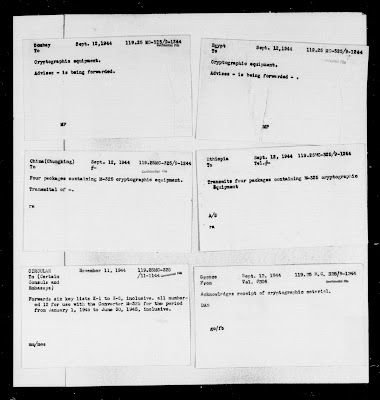In the essay The
French War Ministry’s FLD code I’ve added the following information:
Identifying
the FLD codes
We can try to
identify the cryptosystems used in the FLD radio network by looking at
Huettehnain’s statements and various TICOM documents.
According to
Army cryptanalyst dr Buggisch (7) the designations F90 and F110 referred to
French Army ciphers, read during the period 1939-1940:
‘F90 and
F110 were German designations for French Army cipher systems before and during
the campaign in FRANCE. Both were based on a four figure code, in one case the
recipher consisted of a periodic adder [or subtractor] of length 11; in the
other it was ordinary transposition, the transposition key being obtained from
a key word which itself was taken from the code and shown by an indicator
group. Both systems were being read from the winter of 39/40 to the end of the
French campaign. Solution was by methods generally known in cryptanalytic
circles. One of the codes turned, up again for a short period in De Gaullist
traffic.’
Note that
Buggisch’s description of the systems is similar to Huettenhain’s from ‘Einzeldarstellungen
aus dem Gebiet der Kryptologie‘.
In the TICOM
collection of the German Foreign Ministry’s Political Archive there are
documents that have more information on the ciphers F90 and F110:
1). The TICOM
documents T3611 and T3612 (8) have information on cipher F90, however document
T3611 is not available due to deterioration.
According to document
T3612 the cipher F90 was a 4-figure code enciphered with short additive
sequences of 5, 7 or 11 digit length.
It seems that the codebook consisted of 20 pages, each with 100 entries, totaling
2.000 code groups.
This system was
used by the network FLD (Paris) in communications with stations fla, flb, flc, flf,
flg, fak, fam, flq and others and it was solved thanks to a major cipher clerk
error committed in September 1937.
It seems that
the same message was sent twice, first without encipherment (so only the code
groups were transmitted) and then with additive encipherment. Clearly this gave
the German codebreakers an opportunity to identify the basic code groups and
then solve the additive sequence used for encipherment. This success allowed
them to correct their own relative code findings (from previous decipherments) into
the actual French code values.
The information
in TICOM document T3612 matches Huettenhain’s statements about a high level
code enciphered with short additive sequences being solved completely in the
years prior to WWII.
2). The TICOM document
T3684 (9) describes system F110 (F4ZCW110 - French 4-figure code with simple
transposition) and it says than from February 1938 the radio network of the
French 14th Army, with stations in Lyon, Grenoble, Modane, Briancon,
Chambery, Jausiers and Beurg-Saint-Maurice, started using this transposed code.
The indicator was 55555 and the transposition key was created from the plain
meaning of one of the codegroups. The example given in the report was:
p e r m i s s i
o n o n n a i r e
13 2 14 7 4 16 17 5 11 8 12 9
10 1 6 15 3
The details in
the report match Huettenhain’s statements about a French military district adjacent
to Italy using a transposed code, with the transposition keys being created
from the codegroups of the codebook and the first breakthrough coming in 1938.
The
successors to systems F90 and F110
From the
available TICOM documents it seems that in September 1939 both systems were
changed. Cipher F90 was replaced by a new 3-figure code plus additive, while
cipher F110’s successor used the same underlying code but with a new
encipherment procedure.
1). TICOM
document T3661 (10) contains a report by the cryptanalyst dr Ludwig Föppl,
dated 18 December 1939. In the report Föppl says that the code F90, which was
used in the military command radio network FLD (Paris), was changed in
September and replaced by a new system.
The new system
was a 3-figure code enciphered by additive sequences. It seems the encipherment
consisted of a 20-digit number that was composed of two 10-digits parts. A
peculiarity of the encipherment was that each 10-digit number was composed of
all the ten digits from 0 to 9 used only once (11). This system was solved and
it seems that the German designation for it was F135.
2). In the
notes of dr Huettenhain there is a report from November 1939 that describes the
solution of the successor to system F110 (12):
‘Report
on the attachment to Army Group C evaluation section
On 2
September 1939 the French Army Code F110 was replaced by a new code so that
traffic could no longer be broken currently.
On 3
September 1939 I was seconded to FRANKFURT-ON-MAIN in order to take part in the
task of breaking this new code. The task was accomplished at the beginning of
October so that all the September material could be read retrospectively.
This success
was made possible in such a short time by the fact that
1) the
necessary data (Code etc) was obtained by months of work in peace time, chiefly
by Herrn TRAPPE (Chi OKW) and SCHMIDT (Chi OKW)
2) a close
co-operation between the above named gentlemen and me could be established.
It was
therefore, still possible in October to work on the October material with
success. In addition to the above named gentlemen Herr Professor Dr. FOPPL was
of great assistance in the solution of this system.
As the
system was not changed on 1 November 1939 this code could be read currently
again from the date when the October key was broken. On 3 November 1939 at the
finish of my attachment in FRANKFURT-0N-MAIN I was sent to BERLIN.’
From
Huettenhain’s report it seems that the underlying code remained the same (as in
system F110) but the encipherment procedure was changed. By having the code the
German codebreakers only needed to attack the encipherment and this was quickly
achieved according to Huettenhain.










